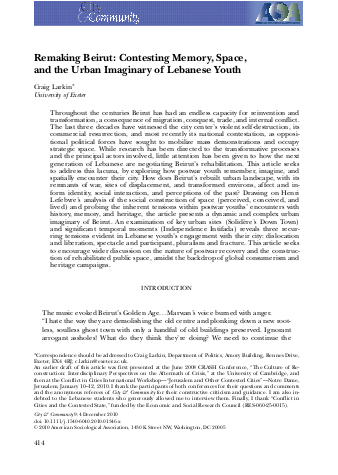
Throughout the centuries Beirut has had an endless capacity for reinvention and transformation, a consequence of migration, conquest, trade, and internal conflict. The last three decades have witnessed the city center’s violent self-destruction, its commercial resurrection, and most recently its national contestation, as oppositional political forces have sought to mobilize mass demonstrations and occupy strategic space. While research has been directed to the transformative processes and the principal actors involved, little attention has been given to how the next generation of Lebanese are negotiating Beirut’s rehabilitation. This article seeks to address this lacuna, by exploring how postwar youth remember, imagine, and spatially encounter their city. How does Beirut’s rebuilt urban landscape, with its remnants of war, sites of displacement, and transformed environs, affect and inform identity, social interaction, and perceptions of the past? Drawing on Henri Lefebvre’s analysis of the social construction of space (perceived, conceived, and lived) and probing the inherent tensions within postwar youths’ encounters with history, memory, and heritage, the article presents a dynamic and complex urban imaginary of Beirut. An examination of key urban sites (Solidere’s Down Town) ` and significant temporal moments (Independence Intifada) reveals three recurring tensions evident in Lebanese youth’s engagement with their city: dislocation and liberation, spectacle and participant, pluralism and fracture. This article seeks to encourage wider discussion on the nature of postwar recovery and the construction of rehabilitated public space, amidst the backdrop of global consumerism and heritage campaigns.